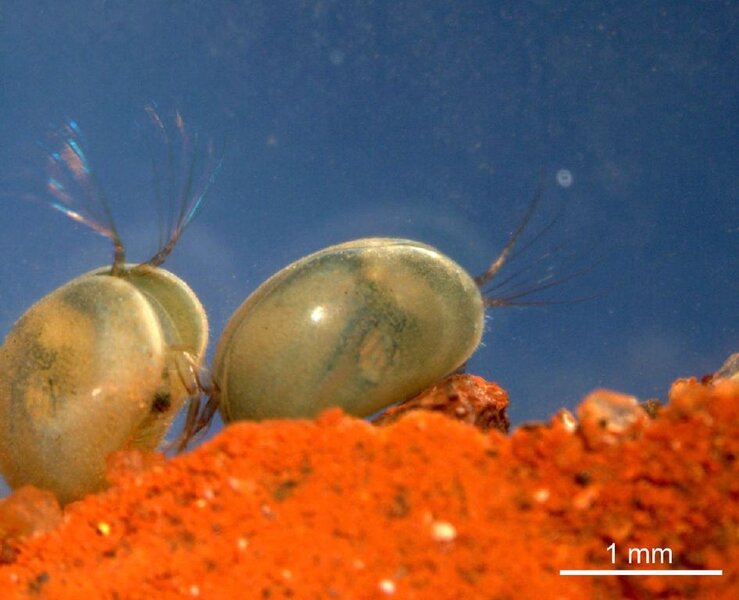Scientists discover world's first fossilized sperm, and they're humongous
Loading...
In a watery, bat-dense cave in Australia some 17 million years ago, tragedy befell a cluster of seed shrimp during their mating season. Immediately upon copulating, at least five of the tiny, water-borne crustaceans were abruptly covered with sediment – a splotch of bat guano, perhaps, or a clod of wet dirt dislodged from the cave's wall.
Many geological eras later, a group of scientists who study ostracods – a class of small, flat crustaceans measuring about a millimeter – uncovered this tiny time capsule and found something extraordinary: petrified sperm coiled inside all five creatures. These are the first sperm to enter to the fossil record.
They are astoundingly large. The coiled, now-petrified sperm are hard to measure, but based on the proportions of similar species alive today, the scientists estimate these sperm may be 1.3 millimeters long, slightly longer than the creatures themselves. They used microtomography and nanotomography to image the fossils without breaking them.
So much about this finding is peculiar, beginning with the fact that the sperm managed to become petrified at all. It seems to have happened in part thanks to their sudden entombment, and in part because the sperm cells were covered by a hard, protective shell of chitin, the substance that makes up insect skeletons. Unlike plant cells, whose rigid walls help maintain structures as plants fossilize, animal cells are normally soft, and thus far less resistant to time's ravages.
In addition to their odd hard shells, these sperm, unlike most known modern sperm, lacked tails.
"Although tailless, these gargantuan gametes are motile," reports the study, published in today's issue of the Proceedings of the Royal Society of Biology. "Contractile organelles produce both ripples along the length of the posterior region and longitudinal rotation of the entire sperm, and all of the sperm body enters the egg during fertilization."
Another reason why these gametes were preserved so well, was probably the high concentration of phosphate in the cave's water, thanks to the bat guano.
"Fossilization is often present in phosphatic environments," says Renate Matzke-Karasz, the ostracodologist from Munich's Ludwig-Maximilians University who led the study.
By itself, the size of these sperm isn't entirely unusual. Modern ostracods are one of a handful of animal groups that, for unknown reasons, have evolved giant sperm cells. But what's shocking is knowing how long these tiny animals have found it worthwhile to invest so much energy in their sex cells.
The sperm of today's ostracods have hardly changed at all, from the time of their Miocene ancestors, indicating that "giant sperm have only evolved once in ostracods," says Dr. Matzke-Karasz. "It seems it's a very successful reproductive mode over an extremely long time."
The sex organs of these five animals have also been exquisitely preserved. The filamentous sperm are bundled into the vas deferens of one male Heterocypris collaris, and the seminal vesicles of three females of the same species, as well as a female Newnhamia mckenziana. According to Matzke-Karasz, these organs indicate that the species' male and female sex organs co-evolved. "It is very clear that the female developed organs that are adapted to these long sperm," she says.
Why these animals evolved and kept such outsized sex cells is a mystery that Matzke-Karasz is now trying to crack by watching their living descendants reproduce. "We want to learn about the very basics. We don't know a lot about the facts around the copulation of arthropods," she says. "How long do these sperm live in the female? How does she use the sperm? Does she use the sperm from the last male she copulated with, or the first one?"
The field of micropaleontology, which examines tiny fossils like these ones, provides important context for geological and paleontological findings. Dating geological layers, Matzke-Karasz says, is the "core purpose of micropaleontology." Another application, she adds, "is the reconstruction of paleoenvironments, because ostracods are very particular in their environmental tolerance."
The most exciting part of this finding, she says, is its revelation "that there's so much hidden that we're not aware of. I'm quite sure that we don't need to excavate many more fossils. There are so many osctracods tucked away in collections that we can now study using modern techniques."








